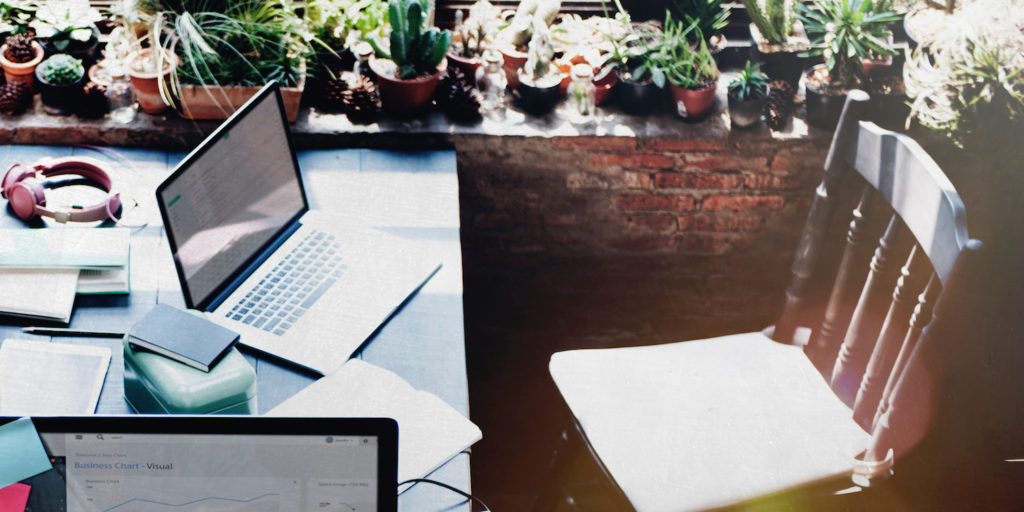
Keeping it cozy! Working from home in the cold months

Brrrrr it's a bit cold isn't it!
One of my favourite permaculture design principles - and one of the most important to get your head around when understanding how useful this design system can be - is "Capture and Store Energy". This principle is an important one for me when I'm working from home in the colder months, because our house is a cool one and my body simply doesn't like the cold. However running the heater all day isn't very good for the planet or my power bills! So my aim is always to use as much free heat energy as possible to keep myself warm.
We have one living room that is our winter lounge. The room is insulated, carpeted, heated and can be sealed. Unfortunately, it doesn't have very good natural light and it also has comfy couches and a TV; not exactly a conducive space for getting lots of work done! The space where I prefer to work has a good desk, good light and nice views out the window into my garden so it's an inspiring and vibrant space. But this space is like an ice box in the morning.

Cozy solutions
I have a lovely, comfortable - yet still ergonomic - chair that is positioned perfectly to capture the morning sun. On cold mornings I sit in this chair with a blanket on my lap, a hot water bottle behind my back, and the sun streaming through the window to give me warmth and lovely light. I don't stay there all day, but I try and do at least an hour while I clear email and organise what projects I need to knock off during my work day. This strategy saves on my power bills, helps keep me energised and productive, and helps break up my day. This is a great example of what permaculture likes to call 'value stacking'.
If you're interested in knowing a bit more about indoor permaculture and how it relates to interior design, I highly recommend this article by indoor permaculture pioneer Cecilia Macauley. I read this article a number of years ago now and it planted an amazing seed in my head in terms of how I understand the applications of permaculture design in all areas of our lives.
-------
Capturing and storing energy is a really important idea to get used to thinking about when it comes to running a business. What are the energies that flow through your business? Have you thought about how you're capturing those energies? Think about customers, ideas, time and money as a few examples of energy that flows through your business. Your aim should be to slow, spread & sink these energy flows, so you can draw on them when you need them.
First impressions count
One of the most important energies a business uses is the attention of a customer. We've all heard the expression "first impressions count" and in the noise and chaos of online marketing, those first impressions are critical. If a potential customer sees a promoted post on Instagram, for example, their attention is a form of energy to capture. This may be the only time a customer ever has exposure to your business so it's super important to make this interaction count.
When designing landscapes (especially in Australia!) one of the most important energies to capture and store is water. Free water comes from the sky, so it makes no sense for the water that comes onto your property to just flow straight off again. So we build dams, harvest water off roof-tops and build different structures into the landscape to capture that water; so it's there when we need it. The objective of this design strategy is to slow the water down, spread it out, and then sink it in storage.

Imagine all the web traffic out there is like water. When it comes by your business, you want to capture and store that traffic for future use. Of course, when it comes to web traffic, not all raindrops are the same so our storage designs are a lot more sophisticated than a water tank. However the capture principle remains key.
Spend some time observing your online presence and imagine you are a potential customer. What are the journey experiences your traffic are experiencing as they flow past your content? Think about the points where your potential customer might pause and reflect and make sure you're asking for their contact information at those points. One of the mistakes many businesses when capturing email leads is asking too soon or too late. But the biggest mistake is not capturing them at all.
Observation is key
Another useful trick is to observe your behaviour when you sign up to mailing lists. You're probably like me and quite discerning about when and where you give someone your contact details. So when you do decide to, make note of what was the influencing moment that made you think 'yes'. It's also very helpful to observe the number of times you don't. The more you can observe your own behaviour and understand what motivates your decisions, the easier you will find it to understand the science of online marketing when applying it to your own business.
Working in marketing and communications I consider the capture and store energy principle every day and I find it a very useful tool for designing user interfaces and double checking final products. Can you think of energies that flow through your business? Let me know in the comments below!
This article is part of Ground Up Creative's ongoing series about applying permaculture principles to your business. Get these great, free articles delivered straight to your inbox and subscribe today!
Want to know more about permaculture design and your business? Get in touch and book in your free chat today.